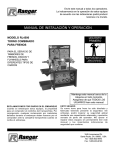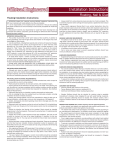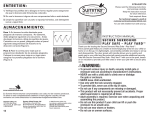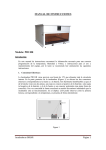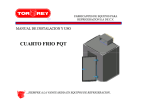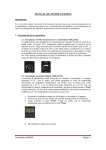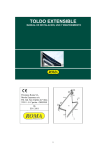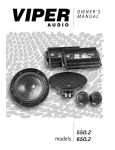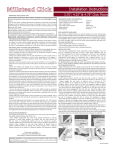Download TrafficMASTER InterLock 184368 Installation Guide
Transcript
IN S TAL LAT I O N I NS T RUCTI ONS General description: TrafficMASTER™ InterLock is a uniquely engineered luxury vinyl plank in a 6in x 36in format with a mechanically locking fastening system. (See 1) No special adhesives or Tongue Side Groove Side 1 glues are required. TrafficMASTER InterLock is installed as a “floating” floor so it can be installed over a wide range of subfloors including wood, concrete, existing vinyl and vinyl composition tiles, as well as existing ceramic tile. Since no under pad is required, it may be necessary to “skim coat” over deeply embossed existing resilient flooring and to smooth out ceramic grout joints before installing TrafficMASTER InterLock. TrafficMASTER InterLock must not be installed over carpet of any kind. Estimating and layout: TrafficMASTER InterLock is packaged 22.66 square feet per carton. Determine the required amount of flooring by multiplying the length to the width of the room. In most cases, it is advisable to add approximately 10% to this total to allow for overage due to cutting and fitting. Divide this total square footage requirement by the number of square feet in a carton to determine the number of cartons required. 2 Plan your layout so the long dimension of the plank is oriented to the long dimension of the room. Most times it is advisable to have the long dimension of the plank oriented parallel to the incoming light from windows. (See 2) Work from several cartons at a time to ensure a good balance of color, shading and texture. Job site conditions: TrafficMASTER InterLock is to be installed in climate-controlled indoor environments only. The job site temperature should be at least 65°F to 85°F for twenty four hours before, during and after the installation. Minimum temperature should then be maintained at 55°F. TrafficMASTER InterLock should be protected from direct exposure to sunlight. In new construction or heavy renovation projects, TrafficMASTER InterLock should only be installed after the other trades have completed their work and the area is in a “clean and debris free” condition. 1 While TrafficMASTER™ InterLock planks are not susceptible to damage from moisture, excessive subfloor moisture is an ideal breeding ground for mold, mildew and fungus – all of which can contribute to an unhealthy indoor environment. The subfloor must be dry, smooth and clean. TrafficMASTER InterLock Installation: TrafficMASTER InterLock is designed to be installed as a “floating” floor. Do not secure the planks to the subfloor. Always undercut all doorjambs. Do not install cabinets or kitchen islands on top of TrafficMASTER InterLock. Use care when installing wall moldings and transition strips – do not fasten through the TrafficMASTER InterLock. It is important to balance the layout of the plank format. Proper planning and layout will prevent narrow plank widths at wall junctures. Determine layout to prevent having less than ½ plank width (2in) or very short pieces. If the first row of planks does not need to be trimmed in width, it will be necessary to cut off the unsupported tongue so a clean, solid edge is toward the wall. As with all plank products, lay the long dimension of the plank parallel to the long dimension of the work area. 5/16 in Expansion Gap Ins tal l Le ft to Rig ht 3 5/16 in Expansion Gap Angle End Tongue Into End Groove 4 5/16 in Expansion Gap Ins 5 tal l Le ft to Rig 1 ht 2 Accurately measure the room to determine the centerline, adjust this established line to accommodate a balanced layout and then transpose this line to a comfortable width away from the starting wall (approximately 2ft to 3ft wide). Determine if the starter row will need to be cut. Position the first plank so that both the head and side seam grooves are exposed. This requires installing the product from left to right in the room. (See 3) Install the second plank in the row by angling the end tongue into the end groove of the first plank. Be careful not to bend the corner of the plank. Maintain an expansion gap of approximately 5/16in from the wall. (See 4 and 5) Then cut a plank to length to start the second row, stagger the end seam at least 6in from the first plank. Install the first plank in the second row by inserting the long side tongue into the groove of the plank in the first row. This is best done with a low angle of the plank. (See 6) 2 Install the second plank in the second row by inserting the short end tongue into the previously installed plank groove. Align the plank so the long side tongue tip is positioned just over the groove lip of the plank in the first row. Working from the end seam, with a low angle insert the long tongue into the groove of the adjoining plank. Very little force is required to seat the tongue into the groove. You will feel the tongue lock into the groove. (See 7 and 8) 6 Work across the length of the room installing planks along the wall in the first row and then aligning the planks in the second row. It is critical to keep these two rows straight and square, as they are the “foundation” for the rest of the installation. Check squareness and straightness often. Cut the last plank in the first row to fit approximately 5/16in short of the end wall. Planks may be cut with a utility knife using the “score and snap” technique. Often times the remainder of this plank may be used to start the third row. (See 9) 7 8 5 3 1 4 9 5/16 in Expansion Gap 2 Continue installing planks, being certain to maintain a random appearance and offset end seams by at least 6in. Maintain a 5/16in expansion space at all fixed vertical surfaces. (See 10) Check to be certain all planks are fully engaged. If slight gapping is noticed, the gap can be tapped closed by using a scrap of flooring and a tapping block. When fitting under door casings, etc. the flexibility and low angle of connection of the TrafficMASTER™ InterLock product become evident. If necessary, a flat pull bar or “last board puller” may be used to assist in locking the planks. 10 When fitting around obstacles or into irregular spaces, TrafficMASTER InterLock can be cut easily and cleanly using a utility knife with a sharp blade. It is often beneficial to make a cardboard template of the area and transfer this pattern to the plank. 3 Protect all exposed edges by installing wall molding and/or transition strips. It is recommended to use proper transitions that are designed for floating LVT floors that provide adequate expansion of Traffic Master InterLock Flooring. It is best if transitions are used at doorways, room changes, level changes or product changes. Use caution to prevent the fasteners from securing the planks to the subfloor. Like with all floor coverings, close your curtains or blinds where extreme sunlight hits the floor. A combination of heat and sunlight can cause most home furnishings fading, discoloration or thermal expansion. Prolonged direct sunlight can result in discoloration and excessive temperatures may cause floor to expansion (which may cause buckling) or delamination. Repairing TrafficMASTER InterLock: Although TrafficMASTER InterLock is tough, it is not indestructible. We suggest you keep several planks from the original installation to be used when replacing a damaged plank. If the damaged plank is along the perimeter of the room, the easiest technique is to just disconnect the planks until the damaged plank is removed. Replace the plank and reassemble the planks. If its impractical to just disconnect and reassemble the planks the following procedure should be used: Using a straight edge and a sharp utility knife, cut out the center of the damaged plank leaving approximately a 1in strip attached to the surrounding planks. Carefully cut back from the corners of the plank to the inside edge. Remove the plank edges by wiggling the cut plank out from the tongue and groove of the surrounding planks. Prepare the replacement plank by placing the face of the plank down and folding back and removing the groove strip on both the long and end profile. Using the decorative surface of the tongue end as a guide, cut away this over-hanging profile using a sharp utility knife. Position the replacement plank by engaging the tongue of the long side into the groove of the adjoining plank. “Hinge” the prepared replacement plank into position. Apply a thin application of “super glue” (cyanoacrylate glues) into all four seams of the replacement plank. Do not get the glue on the surface of the flooring. Place weights on the replaced plank for at least 15 minutes until the adhesive secures the planks. For more information call: 1-800-835-2656. 4 IN STRUCCIO NE S DE I NS TAL ACIÓ N Descripción general: TrafficMASTER™ InterLock es una tabla de lujo de 15,24cm x 91,44cm hecha de vinilo, con un diseño exclusivo que permite que fijarla mediante un sistema de sujeción mecánica. (Ver 1) No se Lado con ranura Lado con lengüeta 1 necesitan adhesivos o pegamentos adicionales. TrafficMASTER InterLock se instala como piso “flotante” por lo que se puede usar sobre una amplia variedad de contrapisos incluyendo madera, concreto, vinilo existente y losas con composición de vinilo además de losas de cerámica ya existentes. Debido a que no se necesita una almohadilla como base, los pisos con detalles en relieve pueden requerir una capa de enlucido para emparejar las uniones de lechada antes de instalar el TrafficMASTER InterLock. TrafficMASTER InterLock no se debe instalar sobre ningún tipo de alfombra. Estimación y diseño: Cada caja de TrafficMASTER InterLock contiene 2,10 metros cuadrados de tablas. Multiplica el largo de la habitación por el ancho de la misma para determinar qué cantidad de tablas requerirás. En la mayoría de los casos, se recomienda añadir aproximadamente 10% al total para compensar el material que se pierde al cortar y ajustar las tablas. Divide el total de pies cuadrados necesarios entre los pies cuadrados contenidos en una caja para saber cuántas cajas necesitarás. 2 Planifica el diseño, de modo que el largo de la tabla esté orientado a lo largo de la habitación. La mayoría de las veces se recomienda que se oriente el largo de la tabla paralelo a la luz entrante de la ventana. (Ver 2) Trabaja con varias cajas a la vez para garantizar un buen balance de color, sombras y textura. Condiciones del lugar de trabajo: TrafficMASTER InterLock se debe instalar únicamente en ambientes interiores con control de clima. La temperatura del lugar de trabajo debe ser de, al menos, 65°F a 85°F por veinticuatro horas antes, durante y después de la instalación. La temperatura mínima se debe mantener en 55ºF. El TrafficMASTER InterLock no debe exponerse a la luz directa del sol. En nuevas construcciones o proyectos donde la renovación haya sido extensa, se debe instalar TrafficMASTER InterLock únicamente después de que se hayan completado otros trabajos y una vez que la zona esté “limpia y sin escombros”. Español 5 Aunque las tablas TrafficMASTER™ InterLock no son susceptibles a los daños por humedad, la humedad excesiva del contrapiso puede propiciar la aparición de moho y hongos, lo que generaría un ambiente no saludable. El contrapiso debe estar seco, liso y limpio. Instalación del TrafficMASTER InterLock: TrafficMASTER InterLock está diseñado para instalarse como un piso “flotante”. No asegures las tablas al contrapiso. Siempre corta por debajo del nivel de las jambas de las puertas. No instales gabinetes o islas de cocina sobre TrafficMASTER InterLock. Ten cuidado cuando instales molduras para pared y tiras de transición; no las sujetes a través del TrafficMASTER InterLock. Es importante que distribuyas las tablas parejamente. Planifica la distribución de modo que el lado angosto de las tablas no dé hacia las uniones de las paredes. Distribuye las tablas de manera que ninguna sea muy corta o mida menos de 5,08 cm de ancho Cuando no sea necesario reducir el ancho de la primera hilera de tablas, deberás cortar la lengüeta sin apoyo para que haya un borde sólido y limpio de cara a la pared. Como con todos los productos de tabla, coloca el lado largo de la tabla a lo largo del área trabajo. Toma las medidas exactas de la habitación para ubicar la línea central; usa esta línea para lograr una distribución adecuada de las tablas y luego trasládala hasta una distancia conveniente de la pared de inicio (aproximadamente a un ancho de 60,96cm a 91,44cm). Determina si la fila de inicio se deberá cortar. Espacio de expansión de 0,79cm Ins a d talar ere de cha izq u ierd a 3 Coloca la primera tabla de modo que la cabeza y las ranuras laterales queden expuestas. Para lograr lo anterior, debes instalar el producto de izquierda a derecha en la habitación. (Ver 3) Espacio de expansión de 0,79cm 4 Instala la segunda tabla de la fila colocando el extremo con lengüeta en ángulo con la ranura de la primera tabla. Ten cuidado de no doblar la esquina de la tabla. Mantén un espacio de expansión de aproximadamente 0,79cm desde la pared. (Ver 4 y 5) Luego corta una tabla a la medida deseada para comenzar con la segunda fila, alterna la unión del extremo a un mínimo de 15,24cm de la primera tabla. Insertar lengüeta en la ranura de manera inclinada Espacio de expansión de 0,79 cm Ins a d talar ere de cha izq u ierd 1 a 2 5 6 Español Instala la primera tabla en la segunda fila insertando la lengüeta del lado largo en la ranura de la tabla en la primera fila. Insertar la tabla en ángulo facilitará la instalación. (Ver 6) Instala la segunda tabla de la segunda fila insertando la lengüeta del lado corto en la ranura de la tabla que instalaste anteriormente. Alinea la tabla de modo que punta de la lengüeta del lado largo quede justo sobre la ranura de la tabla en la primera fila. Trabaja desde la unión del extremo, en un ángulo no muy pronunciado, inserta la lengüeta larga en la ranura de la tabla contigua. Se necesita muy poca fuerza para colocar la lengüeta en la ranura. Sentirás cuando se trabe la lengüeta en la ranura. (Ver 7 y 8). 6 7 Trabaja a lo largo de la habitación para instalar las tablas a lo largo de la pared en la primera fila y luego alinea las tablas en la segunda fila. Es muy importante mantener estas dos filas simétricas y rectas ya que son la “base” para el resto de la instalación. Verifica con frecuencia que la instalación esté quedando derecha y simétrica. Corta la última tabla de la primera fila para que quede a aproximadamente 0,79 cm de la pared. Las tablas se pueden cortar con un cuchillo multiuso utilizando la técnica “marcar y cortar”. Con frecuencia el remanente de esta tabla se puede usar para comenzar la tercera fila. (Ver 9) 8 5 3 1 4 9 Espacio de expansión de 0,79 cm 2 Sigue instalando las tablas, asegurándote de seguir un patrón aleatorio y de escalonar las uniones en un mínimo de 15,24 cm Deja un espacio de 0,79 cm para la expansión de las tablas en todas las superficies verticales fijas. (Ver 10) Revisa que todas las tablas estén completamente acopladas. Si se queda un pequeño espacio, este se puede rellenar usando un recorte de tabla y un bloque para martillar. Cuando se coloca bajo los marcos de las puertas, etc. la flexibilidad y el bajo ángulo 10 de conexión del TrafficMASTER InterLock se hacen evidentes. De ser necesario, se pueden usar una barra plana para hacer palanca o un “last board puller” para encajar las tablas. Español 7 Cuando se coloque alrededor de obstáculos o en espacios irregulares, TrafficMASTER™ InterLock se puede cortar limpia y fácilmente usando un cuchillo multiuso con una hoja afilada. Con frecuencia es bueno hacer una plantilla de cartón del área y transferir este modelo a la tabla. Protege todos los bordes expuestos instalando molduras para pared y/o tiras de transición. Se recomienda usar las transiciones adecuadas que están diseñadas para pisos LTV flotantes que proporcionan la expansión adecuada del piso Traffic Master InterLock. Es mejor si las transiciones se usan en umbrales de puerta, cambios de habitación, variaciones de nivel o cambios de productos. Ten cuidado en evitar que los sujetadores fijen las tablas al contrapiso. Cierre las cortinas o las persianas cuando la luz solar extrema impacte el piso. La combinación de calor y luz solar puede ocasionar que el color de la mayoría del mobiliario y la decoración interior se atenúe o decolore o presente expansión térmica. La exposición prolongada a la luz directa del sol puede producir decoloración y las temperaturas excesivas pueden causar la expansión del piso (lo que a su vez puede provocar torceduras o pérdida del laminado). Reparación del TrafficMASTER InterLock: Aunque TrafficMASTER InterLock es resistente no es indestructible. Sugerimos que guardes varias tablas de la instalación original para usarlas cuando reemplaces una tabla dañada. Si la tabla dañada se encuentra a lo largo del perímetro de la habitación, la técnica más fácil será desconectar las tablas hasta que quitar la tabla dañada. Reemplaza la tabla dañada y vuelve a ensamblar las tablas. Si no es práctico desconectar y volver a ensamblar las tablas, se debe seguir el siguiente procedimiento: Con una vara de medir y un cuchillo multiuso afilado, corta el centro de la tabla dañada, dejando una tira de aproximadamente 2,54 cm plg unida a las tablas contiguas. Con cuidado, corta desde las esquinas de la tabla hasta el borde interior. Quita los bordes de la tabla desencajando la tabla cortada desde la lengüeta y ranura de las tablas contiguas. Prepara la tabla de reemplazo colocando la cara de la misma hacia abajo y plegando hacia atrás y quitando la tira de ranura a lo largo y extremo del perfil. Usa el lado decorado de la lengüeta para guiarte; corta este perfil que sobresale usando un cuchillo multiuso afilado. Coloca la tabla de reemplazo encajando la lengüeta del lado largo en la ranura de la tabla contigua. “Encaja” la tabla de reemplazo en su sitio. Coloca una capa delgada de “super glue” (pegamento de cianocrilato) en las cuatro uniones de la tabla de reemplazo. Evita ensuciar con pegamento la superficie del piso. Coloca un peso sobre la tabla de reemplazo durante al menos 15 minutos hasta que el adhesivo fije las tablas. Para obtener más información, llama al: 1-800-835-2656. 8 Español
This document in other languages
- español: TrafficMASTER InterLock 184368









